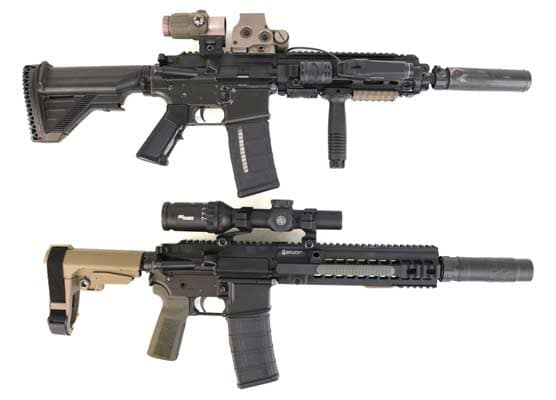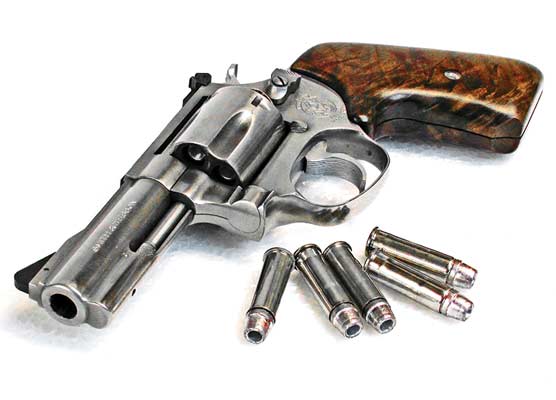Hunting With Sixguns
The Long And The Short Of It
October was made for hunting and the day was perfect. The oppressive heat of summer had given way to frozen mornings and warm afternoons, while the green was rapidly being replaced with gold and red splashes of color. Heavy flannel shirts and down vests
were once again the dress of the day. Yes, it was a perfect day for hunting and the ram was standing almost defiantly broadside at 225 yards. A long shot? Definitely. Could I make it? Maybe. I assumed the steadiest position possible, sighted down the 101⁄2″- barrel of the .44 Magnum Super Blackhawk and squeezed the trigger sending a 265-grain hard cast bullet on its way.
Surprise!
The shot was as perfect as the day. It seemed like an eternity as the flat-nosed bullet made its way to the target and I waited to hear the satisfying whomp as the bullet hit. Instead I heard clang!, for this critter was a steel ram and I was shooting long-range silhouettes. While I was active in silhouettes in the 1980s this happened hundreds of times as I, and thousands of others, successfully took on chickens, pigs, turkeys and rams. Silhouetting taught us a lot about long-range shooting, however most of what we did did not transfer positively to the hunting field unless we were really paying attention.
It’s one thing to shoot a steel animal at a measured distance, standing still, allowing time for the shooter to assume the Creedmore position, with a known gun and load. Silhouetting was and is a wonderful, satisfying sport for handgunners. However it
would be more realistic for the handgun hunter if the targets actually had a kill zone.
In the game fields bullet placement is critical; on steel critters a hit is a hit. I took many rams with perfect shoulder shots, however I also took them with horn shots, ham shots, gut shots, leg shots and even shots which, had they been ewes, would have
been complete misses. It didn’t matter. As long as the ram went down, the shot counted. We don’t have this forgiving situation in the game fields. Bad shots remain bad shots, often allowing animals to escape to die a painful, lingering death. The two equal first rules of hunting are: (1) Use enough gun, and (1A) Respect the animal being hunted.
Reality Sets In
Like most hunters I started my adventures afield with a scope-sighted, bolt action rifle in what was then the most popular
chambering, the .30-06. When I decided to become a handgun hunter I did not strap on the sixgun as a backup but instead left the 06 at home. My 10″ .44 Magnum Ruger Flat-Top in a Goerg shoulder holster carried so much easier than the old sporterized 1917 Enfield. As I made my way up the mountain I appreciated the Ruger more and more. I reached the top, sat down to rest, looked across the canyon and there he was, the biggest mule deer I had ever seen. He was a long way off, however if I had the Enfield I might have been able to move behind the log I was leaning against, roll up my down vest, use it as a rest and take the shot. Instead, I just sat there and enjoyed the view.
He was much too far for an open sighted sixgun even with the relatively flat-shooting .44 Magnum. Perhaps I could have gone down into the canyon and back up to him, however I was definitely too tired and it would be dark before I ever reached him. When you decide to become a handgun hunter, situations like this are to be expected. Three-hundred-yard shots may be possible with the accomplished riflemen, however they are totally out of the question for the sixgunner. I may have been able to hit 225-yard rams most of the time, however I was realistic enough to know my range with an open-sighted sixgun was about one-third this distance — and 50 yards is even better.
Do It Up Close
Handgun hunters need to take a reality check and realize the normal front sight on a sixgun covers 3″ at 25 yards; carried out
to 100 yards the sight covers a lot of area, certainly greater than the kill zone on most animals. Factor in excitement and being out of breath and it becomes very apparent shots should be at close range. Two hundred yards? Three hundred yards? Forget it! Shooting at live targets at such distances, especially with an iron-sighted sixgun is totally irresponsible. We can laugh with our friends when missing a steel ram or a distant rock, however there is nothing funny about wounding an animal.
My latest hunting trip after a Catalina goat is a perfect illustration of hunting with a sixgun and the choices to be made. Each
year my two hunting buddies and I make a trek to Clover Creek Ranch above Madras, Oregon. Lately I have gone back to my roots doing most of my hunting with the .44 Special using the classic Keith load. I have a thing for red Catalina goats and had been
hunting all day before I found any goats.
We finally spotted a herd and tried to get close enough for a shot. For the next two hours I waited. I waited while a wild pig came by and moved them out; I watched as a small herd of buffalo turned them back toward me. The goats finally settled down and I put the Bushnell Laser Rangefinder on “my” pale red goat. He was 123 yards away and I never got any closer. It would be easy to say it was just a Catalina goat and try the shot, however, I cannot operate this way. Fifty yards closer, a steady rest, standing broadside shot, maybe; a 50-yard shot would have been even better.
Bigger = Closer
The previous year at Clover Creek I had taken two huge feral boars with the same .44 Special. A reverse situation exists when hunting. It would be natural to assume the larger the critter the farther away we can shoot; actually the opposite is true. You rarely, if ever, hear of anyone shooting long-range on elephants or Cape buffalo. Shots are up close where a mistake is less likely to be made. I’ve shot pigs in many parts of the country as well as wart hog in South Africa, and javelina in Texas. My longest shot has been well under 50 yards. The two feral boars, a little one at 500 pounds, and his big buddy topping the scale at over 650 pounds, were both taken at 25-35 yards. Pigs are big and tough and can be dangerous; up close is the only way to take
them with a sixgun.
I’ve taken two bison with a revolver A meat cow was taken in a Kansas snowstorm at 50 yards using a heavily-loaded .45 Colt. My trophy bull was taken even closer, about 35 yards, using a Freedom Arms 43⁄4″ Model 83 and Buffalo Bore’s .480 Ruger load. Both are exceptionally big targets, however up close minimizes the chance of a mistake. As I type this, a cougar looks down at me from his log perch above my desk. He was taken out of a tree at 50 feet with a .44 Magnum.
That was probably the hardest hunt I have ever been on, making my way up the side of the mountain in waist-deep snow. I would’ve been happy if he had been even closer. Cougars are relatively easy to kill, however a mistake can get the dogs killed. This one was dead before he hit the ground.
Memories
As I look around my office/trophy room I see a large aoudad taken at 40 yards with a .44 Magnum, a wart hog shot at about 25 yards with a .454 Casull, and several whitetail deer of the dozens I have taken with the .44 Magnum, all one-shot kills. Only one of those whitetails was taken at a distance more than 50 yards. That one exception was a large, old management buck on the YO
Ranch. On this occasion I had my 71⁄2″ Freedom Arms .44 Magnum with a 2X Leupold scope in place. The distance was 125 yards, he was standing broadside and perfectly still, I knew my sixgun well, and I had a solid rest. Even so I felt I was stretching my distance to the maximum; fortunately it worked out perfectly.
Long shots are for the accomplished riflemen or the handgun hunter using a scope-sighted Thompson/Center Contender or Encore, which is often more accurate than a rifle. But for the sixgun hunter, the closer the better. Big bore sixguns are my passion. I enjoy shooting them long-range and when hunting. However, the two do not go together. It’s most enjoyable shooting an iron-sighted sixgun at rocks at distances of 500-800 yards, but when it comes to hunting I drop off that last “0”. Respect for the animal and pride in making one-shot kills are extremely important to me. It’s called sportsmanship.










